Masterpiece: The Hannah Cabinet
Words: Linda Nathan, Wood Review editor
I first met Geoff Hannah some 19 years ago. Smartly dressed in a dark suit he stood every day at an exhibition of fine woodwork at Melbourne’s Royal Exhibition Building1, patiently showing his amazing Yarralumla Cabinet to a constant stream of spellbound visitors.
It was only later that others questioned the description I gave of Geoff. ‘Geoff in a suit? No way!’ Bare feet, t-shirt and stubbies topped off with a spiky blonde crew cut and an ever present smile might more accurately describe the everyday appearance of one of Australia’s bona fide master woodcraftsmen. ‘Gentleman ocker’ might also describe his colourful but always considerate language.
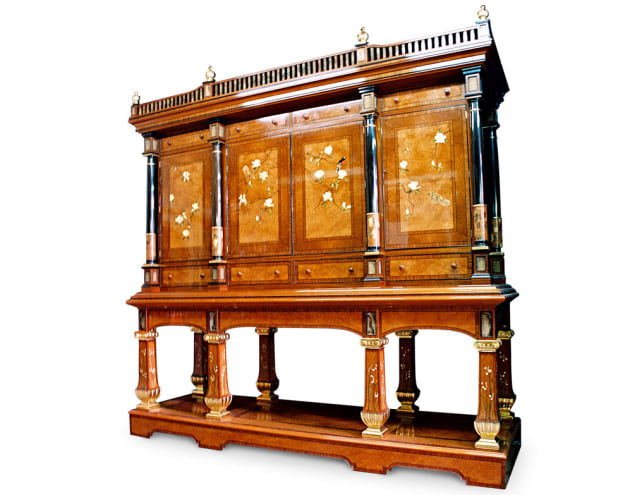
Above: The magnificent Hannah cabinet is 8’x 8’ x 28-1/2” (Geoff works only in imperial measurements). The main construction is Brazilian mahogany veneered in madrona burl, crossbanded in East Indian rosewood, stringed in ebony and inlaid with magnolia. The material cost of the cabinet was more than considerable. Sapphires, peridoes and amethyst are some of the gemstones incorporated, and many of the 130 drawers have semi-precious stone base.. The six columns were turned from $10,000 worth of ebony. Each door features marquetry on both sides. Other materials include pre-CITES listing sourced tortoise shell, ivory and woods. Geoff estimates the cabinet weighs over a tonne and a half.
Now approaching 60, Geoff Hannah has produced four major pieces in a 40-year long woodwork career. On top of numerous other traditionally inspired pieces the Bicentenary Cabinet (1988), Yarralumla Cabinet (1990), Australiana Collector’s Cabinet (1993) and now the Hannah Cabinet (2008), loom large2—in fact each loomed larger than the one before. And each has taken longer to build, culminating in a six year plus completion period for the most recent.
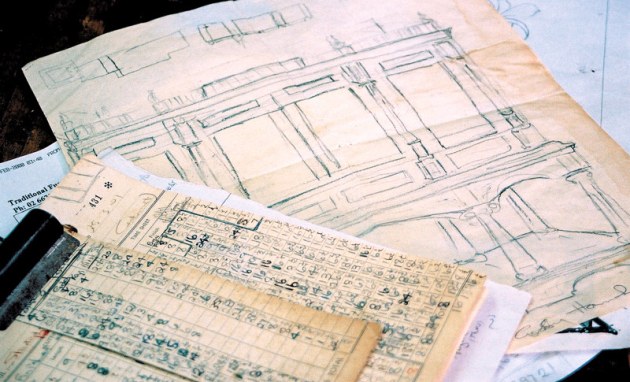
Above: Geoff kept records of hours spent on every conceivable process, starting with ‘25/3/01: idea!’, and then ‘12/7/02: job started’. Completion was initially planned for 2003 to commemorate 30 years in business, but that mark was overshot somewhat. A drawing was produced on 4/1/02 from which full scale drawings were produced from on two sheets of hinged together 8 x 4 ply.
Six years of time sheets are there to show how slow Geoff might be, but the reverse is actually true: Geoff works fast but there’s been a lot to do. Keeping a record of time taken is not about proving anything to anyone; it’s so he knows how to price the cabinet. Totalling expenses (also all recorded) and adding them to what Geoff says will be a ‘reasonable and fair’ hourly rate is how the price will be set.
Time is not really an issue anyway, in fact he was reluctant to say goodbye. ‘Instead of working faster I found myself looking for more to do’, said Geoff. Letting go of a project can be a bit difficult if you’ve enjoyed the process. So there’s been no end of possibilities for incorporating yet another intricately worked marquetry panel or infill.
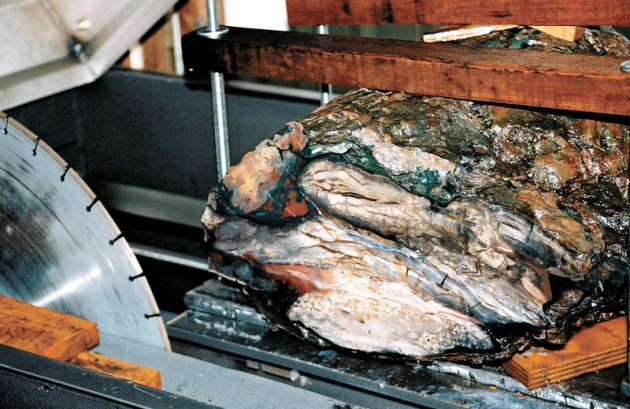
Above: Geoff’s new cabinet showcases the geological marvels of the world.
If you want to incorporate a range of beautifully coloured and patterned semi-precious stones you’d better not be worrying about time taken either. Geoff’s new cabinet showcases the geological marvels of the world: blue lapis from Afganistan, red ruby in zeolite from India, not to mention crazy laced agate from WA and, closer to home, green jasper from Mt Warning and dusky pink rhodonite from the Gold Coast.

Above: Cutting stone is a slow process. Geoff’s son made the saw above which cuts large ‘slices’.
One part of Geoff’s shed contains the three stone cutting machines that slice, grind, bevel and square some of the drawer bases, fronts and other feature components for the big new cabinet. It can take up to ten days to cut just 40 to 50 pieces, sawing has to be slow because ‘it doesn’t take much to break a rock and then you’ve buggered it’, explains Geoff. Running the saws doesn’t come cheap either—$1,300 for 200 litres of the transformer oil that lubricates these babies is a serious investment.
Geoff’s ‘shed’ takes up the whole area under his high set house. During Lismore’s periodic and legendary floods his floorboards have managed to stay above the waterline, but not so below where the water reached eye level in 1974. Not a problem though—when the flood warnings are out mates come and help evacuate all his machinery, tools and work in progress. The new cabinet comes apart into five sections, mainly for ease of transport reasons, flood or otherwise.
There are four areas in the shed, or five if you count the area where Geoff’s original 1960s everyday runabout Mini Cooper is garaged (he’s easy to spot in town). That place also holds a stack of partly made projects belonging to Geoff’s students who come three days a week to learn from the master3.
Stored timber also takes up a significant area under and behind the house. There’s more than he’ll ever use in this lifetime, but buying timber is Geoff’s retail therapy, and he sells some too.
Adding up the hours and dollars spent on the cabinet is not the only numbers game involved—its vital statistics are pretty well all double and triple digit too. There are 18 doors, 130 drawers and 15 secret compartments—and that doesn’t include a few more of the latter that ‘only the bloke who writes the cheque’ will ever know about.
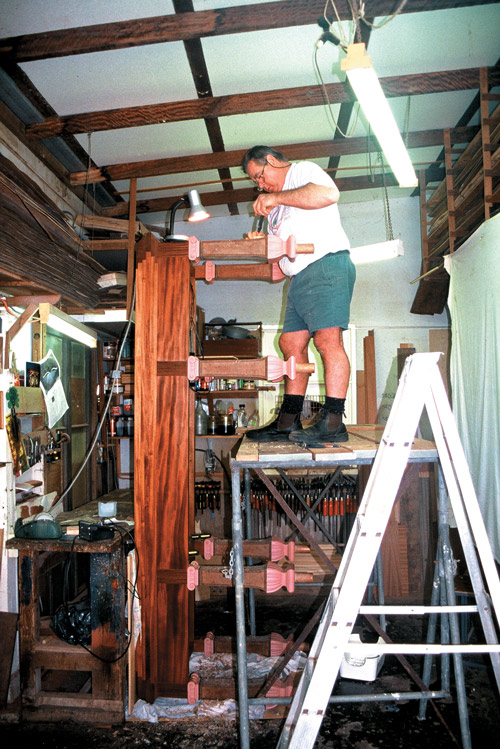
Above: Large scale work needs to be approached from all angles.
Not that selling the cabinet is what matters most to Geoff, and that’s something that he would like to say to some woodworkers. These are the ones who say they can’t afford to dovetail, detail or french polish the way they’d like to, because no one will pay for the time involved. ‘It doesn’t matter how long, how hard or how much it takes’, he says. ‘Make what you want to because you only need one buyer, and if I die soon at least I can say I made what I wanted to. You’ve gotta be happy—you’re only here for a short time.’ Geoff doesn’t mean to sound like he doesn’t care when he says that even if he doesn’t sell the cabinet he’s happy to live with it.
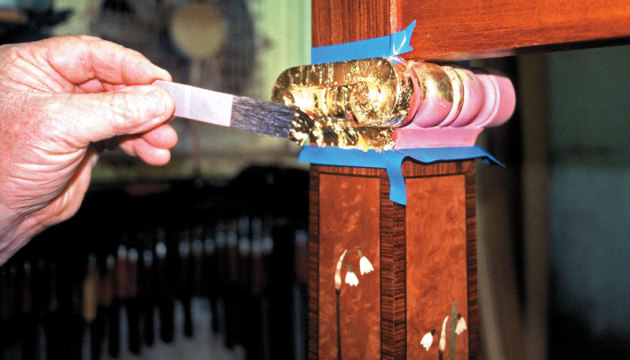
Applying the gold leaf is a delicate process. Prior to guilding the wood receives a coat of gesso to create a smooth surface that the gold leaf will adhere to.
Geoff doesn’t do custom jobs, or advertise for that matter. People will come to him and ask ‘what have you got?’. His house is a kind of live-in gallery, beautifully furnished, with several pieces for sale.
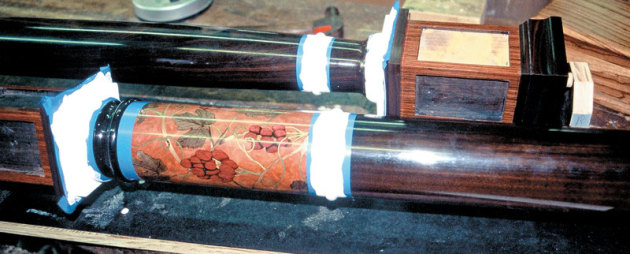
Marquetry panels on the ebony columns were created at the bench and then glued on.
The Hannah Cabinet, named in honour of his family, will be unveiled by the purchaser of his last major piece, which now resides in Antwerp, Belgium. It’s been yet another labour of love. Does he have another big cabinet in him? ‘I have, but Rhonda says “we” haven’t’, is his wife’s highly understandable comment.
1. Geoff Hannah’s Yarralumla Cabinet featured at the 1989 Timber & Working With Wood Show, organised by the founders of that event in Australia, Interwood Holdings Pty Ltd, also founders and publishers of Australian Wood Review magazine. The cabinet featured on the cover of AWR#4.
2. The Bicentenary Cabinet remains in Geoff Hannah’s possession. The Yarralumla Cabinet is owned by the Australiana Fund and resides in Yarralumla, ACT. The Australiana Collector’s Cabinet is part of a private collection in Antwerp, Belgium.
3. This is no ordinary wood school. This year Geoff took 12 of his students to London, Paris, Belgium and Austria for an unbelievable insider woodie tour of the V & A Museum, Windsor Castle, Versaille, the Louvre and more. As an acknowledged master craftsman, a Churchill Fellow with work in collections all over the world Geoff’s credentials open doors.
Reprinted from issue 61, Australian Wood Review, December 2008



